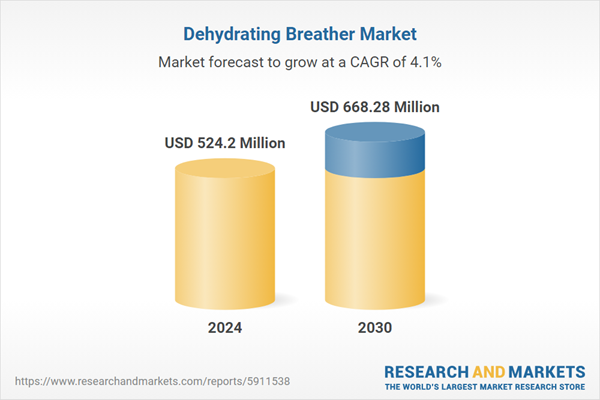Conventional Breather is the fastest growing segment, Asia-Pacific is the largest regional market
Speak directly to the analyst to clarify any post sales queries you may have.
10% Free customizationThis report comes with 10% free customization, enabling you to add data that meets your specific business needs.
Key Market Drivers
The increasing demand for transformer and electrical equipment protection and the expansion of global power transmission and distribution infrastructure represent critical growth catalysts for the global dehydrating breather market. The proliferation of industrial infrastructure and the growing complexity of electrical networks necessitate robust protection against moisture ingress, a primary function of dehydrating breathers in extending equipment life and ensuring grid reliability.According to Hitachi Energy, in April 2024, the company announced a $1.5 billion investment to ramp up global transformer production, directly indicating the escalating demand for assets requiring such protective solutions. Simultaneously, significant global investments in expanding and modernizing power transmission and distribution grids are underway. This includes connecting new generation capacity and reinforcing existing infrastructure. According to the International Energy Agency, in 2023, global investment in power transmission grew by 10% to reach USD 140 billion, signifying a substantial build-out of electrical infrastructure that inherently drives the demand for dehydrating breathers to maintain asset integrity and operational efficiency.
Key Market Challenges
The fluctuating cost and inconsistent availability of critical raw materials, such as silica gel and other desiccants, present a significant challenge to the Global Dehydrating Breather Market. These material dynamics directly increase manufacturing expenses for dehydrating breathers. Such unpredictability makes production planning difficult, potentially forcing manufacturers to absorb higher costs or pass them on to customers through increased product prices.This situation consequently impacts product pricing and supply chain stability. For instance, according to Eurostat, in 2023, the producer price index for the manufacturing of electric motors, generators, and transformers was, on average, 21% higher than 2019 levels. These elevated raw material costs compress profit margins for dehydrating breather manufacturers and can lead to production delays or reduced output. Ultimately, this hampers the market's growth by affecting the affordability and consistent supply of essential protection for electrical infrastructure.
Key Market Trends
Smart Breather Technology Integration for Predictive Maintenance represents a significant advancement in asset management for electrical equipment. This trend involves equipping dehydrating breathers with sensors and communication capabilities, enabling continuous, real-time monitoring of internal conditions such as moisture levels and desiccant saturation.This data facilitates a shift from scheduled maintenance to predictive maintenance, optimizing operational efficiency and minimizing unexpected downtime. According to the International Energy Agency, in 2022, investment in digital-related grid efficiency continued to grow to a new high of USD 63 billion, underscoring the broader push towards intelligent infrastructure. This focus on data-driven insights improves overall grid reliability and extends the operational lifespan of critical assets. In 2024, California ISO ordered the replacement of over 1,200 transformers at storage sites with smart models for rapid charge-discharge management, demonstrating a tangible adoption of intelligent solutions.
Key Market Players Profiled:
- ABB Ltd
- Siemens AG
- Des-Case Corp
- Drytech Inc.
- AGM Container Controls, Inc.
- BTRAC LTD
- Maier GmbH
- Hubbell Incorporated
- TRICO CORPORATION
- Whitmore Manufacturing LLC
Report Scope:
In this report, the Global Dehydrating Breather Market has been segmented into the following categories:By Type:
- Conventional Breather
- Self-Dehydrating Breather
By End User:
- Utilities
- Industrial
- Heavy-Duty Vehicle
By Region:
- North America
- Europe
- Asia-Pacific
- South America
- Middle East & Africa
Competitive Landscape
Company Profiles: Detailed analysis of the major companies present in the Global Dehydrating Breather Market.Available Customizations:
With the given market data, the publisher offers customizations according to a company's specific needs. The following customization options are available for the report.Company Information
- Detailed analysis and profiling of additional market players (up to five).
This product will be delivered within 1-3 business days.
Table of Contents
Companies Mentioned
The companies profiled in this Dehydrating Breather market report include:- ABB Ltd
- Siemens AG
- Des-Case Corp
- Drytech Inc.
- AGM Container Controls, Inc.
- BTRAC LTD
- Maier GmbH
- Hubbell Incorporated
- TRICO CORPORATION
- Whitmore Manufacturing LLC
Table Information
| Report Attribute | Details |
|---|---|
| No. of Pages | 185 |
| Published | November 2025 |
| Forecast Period | 2024 - 2030 |
| Estimated Market Value ( USD | $ 524.2 Million |
| Forecasted Market Value ( USD | $ 668.28 Million |
| Compound Annual Growth Rate | 4.1% |
| Regions Covered | Global |
| No. of Companies Mentioned | 11 |









